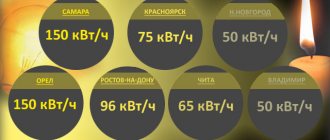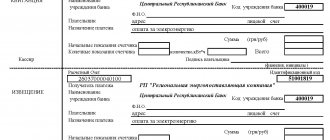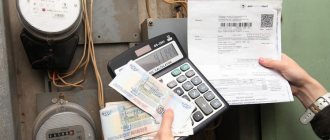What determines electricity prices?
Electricity enters homes through three stages:
- Electricity producers. These are companies that own power plants. Power plants produce energy in various ways: there are nuclear power plants, thermal power plants, hydroelectric power plants, wind generators, solar panels, etc. Depending on the complexity of the equipment and the cost of the energy production work performed, the price per kilowatt set by the manufacturer varies.
- Suppliers. Suppliers are network companies that supply electricity to homes. They are responsible for the quality and maintenance of energy networks.
- Sales organizations. Sales organizations sell electricity to consumers.
Thus, the tariff price consists of three components: the price set by the manufacturer, the cost of energy supply and the premium set by the sales company.
Let's take a closer look at each of the price formation points. Until 2011, the energy producer was subject to state requirements, according to which all energy produced is conditionally divided into two halves. Previously, half of the electricity was sold at wholesale prices, and the other half at market prices. After 2011, the entire volume of energy produced began to be sold at a market rate in order to cover production losses and allocate funds for the development of the energy industry. Accordingly, prices for electricity at the production stage depend on the market price per kilowatt in the global energy market.
The cost of transmitting energy to the consumer can also be divided into two parts. The Federal Grid Company, subordinate to the state, supplies energy from the manufacturer (power plant) to the city or region. Next, energy delivery to homes and businesses is carried out by private enterprises , of which there may be several in one region.
The Committee on Prices and Tariffs sets a cost limit for each of the enterprises, but the final price is determined by its manager. The price set by each enterprise depends on the quality of the equipment used. Thus, even in the same region, residents may pay different prices for electricity if it is supplied by different joint stock companies.
The sales allowance for electricity is formed from the funds necessary for the operation of sales companies. The tariff for payment for their services is also set by the Committee on Prices and Tariffs of a particular region. The job of sales companies is to organize the delivery of energy from the producer to the consumer: they are the ones who purchase the energy produced at power plants, pay for its transportation, and then sell it to residents and businesses.
Thus, the size of tariffs from region to region consists of these three components. Plus, the cost of electricity differs in the city and in rural areas (as a rule, with distance from the city, the tariff increases due to the length and complexity of servicing networks , however, settlements with the status of villages and hamlets receive a 30% discount on the tariff). In houses with electric stoves and gas installations, the tariff is also different: in houses with gas the tariff is higher.
The increase in electricity tariffs is due to the increase in the cost of equipment from the manufacturer and the cost of fuel. Added to this factor is the wear and tear of the power grid: some energy is lost during delivery, and the supplier needs to maintain the grid for efficient delivery. An important issue is with unscrupulous consumers who steal electricity, for which law-abiding citizens have to pay. This problem is especially widespread in enterprises.
What does the electricity tariff consist of?
In the energy sector there are producers, transporters and sellers of electricity. Manufacturers produce and sell electricity. Grid companies, in turn, deliver electricity to consumers. Sales organizations sell electricity to businesses and the public. This chain looks like this: electricity production – transmission through networks – supply (sale to the final consumer). There are entities in the electricity market, each of which is responsible for its part of the work. Stations (hydroelectric power plants, state district power plants, thermal power plants) produce electricity. Through high-voltage networks owned by the state, electricity reaches step-down substations and is then transported through the networks of regional energy companies (in East Kazakhstan region this is JSC "VK REC"). Before reaching the consumer, electricity may visit the networks of energy transmission organizations that are smaller than the REC, but which cannot be bypassed, because it is these networks that the end consumer is connected to. That is, the tariff consists of end-to-end components: production and transportation of electricity. In addition to these costs, there are also the costs of the energy supply organization necessary to carry out its activities.
How are purchasing costs determined?
Electricity producers (hydroelectric power plants, state district power plants, combined heat and power plants, etc.) sell the energy they generate on the so-called wholesale market. The cost of one kWh of each station is approved by the Government of the Republic of Kazakhstan (Resolution of the Government of the Republic of Kazakhstan dated March 25, 2009 No. 392 approved maximum tariffs for 2009-2015 for groups of energy producing organizations).
What determines the cost of services for the transmission of electrical energy?
The energy supply organization pays for electricity transmission services by the state grid, which delivers electricity through high-voltage networks from manufacturers (for example, hydroelectric power stations) to cities and regions, and to regional power grid enterprises.
And here AREM sets its own tariff for each enterprise. It all depends on the cost and quality of network content. How is the electricity sales premium calculated?
So, we consume electricity and pay to the energy supply organization (ESO), which must distribute the money for the kilowatts we consumed to all market entities that took part in our energy supply: stations - once; KEGOC - two, REC - three, other EPOs - four, and there should still be a supply surcharge - a payment directly to the energy supply organization for organizing the sales process between the station and the consumer. Taking into account all these costs, the price of electricity for the energy supplying organization is set by the local Department of the Agency for the Regulation of Natural Monopolies.
Electricity tariffs in the regions
The Russian electricity market is divided into two parts: wholesale and retail. The wholesale market is designed for the sale of power and electricity to large suppliers, such as distribution companies, exporters, and enterprises. The retail market consists of guaranteeing suppliers and sales companies that sell energy to end consumers, i.e. citizens and institutions.
Most of the country is influenced by the wholesale market. In turn, this market is conditionally divided into two territorial zones, which do not depend on each other in terms of prices for the sale of electricity. One part of the zone covers the European part of Russia and the Ural region, and the other – Siberia. In these areas, prices can differ significantly not only from each other, but also within the region itself, and their formation occurs independently.
Special zones (so-called “non-price”) are the Far East, Kaliningrad, Arkhangelsk region and the Komi Republic . These regions are territorially isolated from the unified energy system of Russia, so prices there are organized according to the principle of monopoly: market competition in these areas is impossible for technological reasons.
Electricity consumption varies across regions. This is due to the length of daylight hours, population density, technical equipment and a number of other factors. It should be borne in mind that a consumer, wanting to save money and cutting the amount of energy consumed, causes a reverse reaction: the obligations of sales companies to pay for power remain unchanged, and a decrease in electricity consumption provokes an increase in the tariff, not a reduction (although there are exceptions to this rule).
Economic justification for tariffs
In recent years, we have increasingly seen news that electricity prices have increased. At the same time, new, increased tariffs are called “economically justified.” Does this economic rationale really exist, and by what mechanism is it formed?
According to the legislation of the Russian Federation, electricity tariffs are formed in each subject of the Russian Federation using the criterion of economic feasibility. Tariffs are set by a commission that conducts an independent examination of data on the prices of housing and communal services. The final cost of the tariff consists of the cost of the kilowatt produced and the profit of its manufacturer.
The cost per kilowatt includes material costs (equipment and consumables), payment of employees, current and major repairs, depreciation, etc. When calculating the final tariff, the manufacturer's profit share is up to 12%. The task of the expert organization is to analyze the documentation regulating the cost of electricity production, compare it with the income of citizens in the region and set the optimal tariff for paying for electricity.
Many citizens believe that the increase in electricity tariffs is due to the desire of officials to enrich themselves at the expense of consumers. This is partly true. The current state of affairs in the energy sector demonstrates a huge number of intermediaries on the way from the manufacturer to the buyer, and each of the intermediaries has the right to set its own markup within the limits established by laws. Considering the liberalization of the market and the appetites of some entrepreneurs, such markups in total can be painful for a citizen’s pocket. And given the inaccessibility of some regions and the established monopoly on energy supply in them, prices for supplier services may be deliberately inflated.
How are electricity tariffs set?
Electricity tariffs for the population are set depending on the type of settlement (urban or rural). Moreover, for the urban population they differ depending on whether the residential premises have a gas stove or an electric one (electric heating devices). Also, electricity tariffs can be calculated based on different rates at different times of the day. You can pay for electricity at a single-rate tariff, in which the cost of 1 kilowatt/hour does not depend on the time of day, or switch to a two-zone (day-night) or three-zone (peak, half-peak, night) tariff. In this case, electricity will be cheaper at night and more expensive during the day.
How much do they pay for electricity in Europe?
Electricity prices in the European Union are among the highest in the world. Over the past 10 years, they have grown even more, increasing the difference between the closest trading partners (Russia and China). On average, European residents pay 2-3 times more for electricity than Russian consumers.
High prices in Europe are associated with the high cost of energy production. Oil and gas products, which form the basis of the bulk of electricity produced, are imported into the EU countries via transit routes, acquiring a high cost.
In Russia, in the first half of 2020, the average cost of a kilowatt for the population was 3.1 rubles. For example, in France you have to pay 13 rubles for the same amount of energy, in Italy – 15, and in Denmark – almost 20 rubles. Among countries with developed economies, Russia ranks only third in terms of the cost of electricity ; only Ukraine and Kazakhstan pay less - 2 rubles each. per kilowatt.
But one should not be deceived by the cheapness of a unit of energy. It is much more important to take into account the factor of its accessibility in relation to the income of the population. Here everything is more complicated, since both the value of the national currency and the average wage in the country are taken into account. In this regard , the most affordable electricity in Norway is at a cost of 10.5 rubles per kilowatt. Norwegians can afford 22,563 kilowatts per month. In Russia, despite the apparent cheapness, this figure is only 11,114. The most “unaffordable” price in relation to electricity income in Moldova is 2,258 kilowatts per month at a cost of 5.9 rubles. for a unit.
High energy prices in Scandinavian and European countries are also due to the fact that these states are fighting for a good environmental situation on their territory and on the entire planet. In this regard, it is necessary to abandon “dirty” methods of energy production - for example, from nuclear reactors, which produce the cheapest kilowatts. The emphasis is on more complex, but non-toxic power plants - wind turbines, solar panels, etc.
Thus, there is no point in comparing electricity tariffs in Russia and Europe if the level of income of the population is not taken into account. We are often reassured by the fact that our electricity is one of the cheapest in the world, but this does not make much sense for the population if they have a low income and the national currency depreciates.
Preferential tariff
A preferential tariff provides an opportunity to reduce the cost of electricity.
In order to take advantage of the benefit, you must send documents to Mosenergosbyt in one of two ways:
- through your personal account on the company’s website – on the appropriate tab;
- by directly contacting the nearest Mosenergosbyt branch.
It is allowed to provide both originals and photocopies of documents certified by a notary. The personal presence of the beneficiary is not required - a relative or social worker can apply instead.
How much do they pay for electricity in the CIS countries?
Among the CIS countries, Russia has one of the highest electricity tariffs. Electricity is sold more expensively than in Russia only in Moldova and Armenia. The lowest energy tariffs are in Kyrgyzstan and Tajikistan.
The low cost of tariffs in countries with developing economies is associated with low wages and the difficult economic situation of the population. The state strictly regulates electricity prices, because they are an economically important component of citizens' lives. Increasing tariffs according to market conditions will lead to more citizens approaching the poverty line.
Also, the low price of electricity is associated with the low value of the national currency. It should be noted that among the CIS countries Russia occupies a leading position in terms of wages. Thus, in the countries of the former Soviet Union, electricity prices are logically distributed - the most expensive kilowatt is sold in the richest countries.
Armenia and Ukraine occupy a special position. Although electricity tariffs are still low, in recent years, due to political events, their costs have risen sharply. Further price dynamics remain questionable, because In Armenia, such a decision by the authorities has already caused mass protests.
In general, the CIS countries benefit from the Soviet legacy in the field of energy: developed centralized energy networks, various power plants, efficient production and supply of electricity. Therefore, when comparing Russian prices per kilowatt with world prices, it is more relevant to focus on these countries, and not on Western and European ones.
One-rate tariff for electricity in Moscow
| from 01.01.2020 to 30.06.2020 | from 07/01/2020 to 12/31/2020 | |
| Indicator (consumer groups broken down by rates and differentiated by day zones) | Price (tariff) in rub./kWh | Price (tariff) in rub./kWh |
| 1. Urban population | ||
| Around the clock | 5,47 | 5,66 |
| 2. Population living in houses equipped with stationary electric stoves | ||
| Around the clock | 4,65 | 4,87 |
| 3. Population living in rural settlements and equivalent to them | ||
| Around the clock | 3,83 | 3,96 |
| 4. Gardening, gardening or dacha non-profit associations of citizens | ||
| Around the clock | 3,83 | 3,96 |
| 5. Consumers equal to the population (with the exception of horticultural, gardening or dacha non-profit associations of citizens) | ||
| Around the clock | 5,47 | 5,66 |









